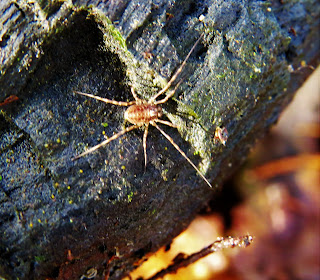 |
| Mum uncovering the hidden world under this log |
This year, I have decided to go on a year-long bug hunt, in search of some of the most fascinating invertebrates that I can find in East Anglia and exploring a range of habitats where they live. So far, I have been searching for razor shells and other seashells on the beach at Titchwell. Today, I am at Mousehold Heath with Mum to uncover the secret world of woodlice and other creepy-crawlies that call the rotting bark of fallen tree branches and trunks home. The woodland floor was littered with these wooden sanctuaries and all that's needed to unlock this hidden world is to roll them over. Simple. However, once we had finished looking under them, we made sure we rolled the logs back to how we found them afterwards.
 |
| Turkeytail |
 |
| Birch Polypore |
 |
| Springtail (a quick sketch of one) |
So what did we discover? Surprisingly, not an awful lot than expected. Most of the creatures we found scurried away within the deep crevices of the logs as soon as we rolled or lifted them up. Possibly the most common creature that was escaping us were springtails, extremely tiny insects that are no bigger than a pin head. They are so small, that it was pointless to even think about photographing them with my bridge camera, not that I could anyway as they have a sufficient method of escaping me in a blink of an eye. As their name suggests, springtails can hop around using a nifty little two-pronged lever under the abdomen called a furcula that can spring them into the air like triggering a mousetrap. They can catapult themselves to quite a distance to where they originally were for something so small.
 |
| Black Slug |
The easiest of the creatures that we encountered under the logs were of course slugs. Unable to move very fast, they instead have another method to evade us. They tuck their sensitive eye stalks in and shrivel up into an unattractive blob. This slug was tiny, I don't think its much of a meal worth my time eating, not that I'd fancy doing so anyway.
 |
| Eggs of possibly a Slug or a Snail |
Just hidden in the leaf litter, Mum found these amazing tiny pearls of jelly. I believe these are in fact the eggs of either a slug or a snail. I don't think I have ever seen slug/snail eggs before, so I am pretty pleased with this little find.
 |
| Centipede |
In these damp, decaying miniature worlds lying on the woodland floor, there is one predator that causes fear in the hearts of all the other creatures. Centipedes are of no harm to us (unless you live in the tropics), but to a woodlouse, they are like a living nightmare. They are fast with many legs attached to the sides of its long flexible bodies that allow them to squeeze through the tiniest of nook and cranny. To top it all off, they also have sharp fangs that inject venom into their victims. It makes you glad that you are not a woodlouse right now doesn't it?
 |
| Harvestman |
Another leggy critter that I found today was this harvestman. Though you may think it looks like a spider and despite being a member of the arachnid family (the same family as spiders), harvestmen are not spiders at all. What separates harvestmen from spiders is the number of body parts (not including the legs). A spider has two body parts, a head and an abdomen. A harvestman only has one. That button you see in the middle of all those long legs is the head and abdomen all in one. They don't use silk to capture prey like their spider cousins, but instead use stealth and wait for prey to crawl by under it's towering legs.
 |
| Common Woodlouse |
All the things I've seen so far were great and all, but they weren't what I was really looking for. What I really wanted to find today were woodlice, but not any old woodlice. I was trying to locate a pill woodlouse, a woodlouse that can roll up into a ball when disturbed. Unfortunately, I could not find any this time round, but I did find a few of the other 37 species of woodlouse found in Britain. Most of them looked like this one, grey and with a slightly spiky-edged body, but I did see one that was smaller and orange in colour. They were surprisingly camera shy as most the ones I could see were either obscured within crevices deep in the bark or ran away. My camera also doesn't like to focus on tiny animals like woodlice for some reason, so I apologize for the poor quality in the photos you can see here. Oh well. Maybe next time.











No comments:
Post a Comment